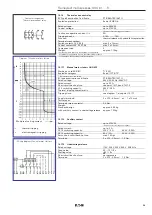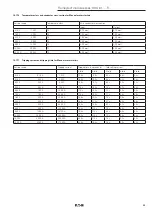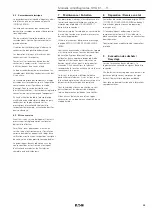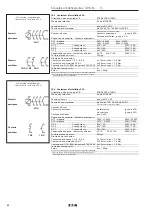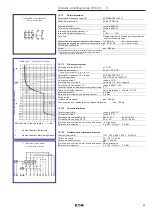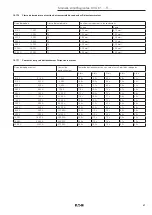
23
10.16
Thermal overcurrent relay
EC-Type Examination Certificate:
PTB 98 ATEX 1087U
Explosion protection:
Ex de IIC/IIB Gb
Rated voltage:
up to 690V AC
Control voltage:
up to 275V AC
(*further control voltages on request)
Continuous operation current I
th
: 6A
Tripping current:
0.16A ........ 16A
Function:
thermal release with phase-failure protection
Terminal cross section:
Switch contacts 1,2,3,4,5,6
max. 2x 10mm²
Control contacts 95, 96, 97, 98
max. 2x 2.5mm²
Component size:
2
Weight:
approx. 1.10kg
The technical data relates to standard built-in apparatus.
- If other built-in apparatus is used, the technical data sheets
or the data on the type label shall be observed.
Flameproof module series, GHG 61. .... R....
Contact arrangement
Thermal overcurrent relay
10.17.1 Manual motor starters GHG 635
Marking acc. to 94/9/EC:
II 2 G
Explosion category:
Ex ed II C T6 / T5*
*
Temperature class, see 10.17.6
EC type examination certificate:
PTB 99 ATEX 1007 U
Rated voltage:
690 V, 50/60 Hz / 440V DC
Rated current:
up to 25 A
Short circuit back-up fuse:
see point 10.17.4 and 10.17.5
AC 3 switching capacity:
690 V / 25 A
Thermal tripping characteristic:
T II
Tripping time:
see diagram 1, also point 10.17.7
Supply terminals:
2 x 0.75 - 4.0mm² or
1 x 10mm²
Test torques:
Terminals (main contacts)
3.5 Nm
Weight:
Standard design
approx. 0.94 kg
with auxiliary contact / undervoltage release approx. 1.25 kg
10.17.2 Auxiliary contact
Rated voltage:
up to 275V AC
(*further control voltages on request)
Rated current:
up to 2 A
AC 15 switching capacity:
230 V / 2 A
400 V / 0.50 A
DC 13 switching capacity:
60 V / 2 A
230 V / 0.25 A
Perm. short circuit back-up fuse:
max. 10 A gL
Terminals:
2 x 0.75 - 2.5mm² 1,5 Nm
10.17.3 Undervoltage release
Rated voltage:
110 V, 230 V, 400 V, 500 V 50/60 Hz
Drop value:
35....75 % Ec
Starting value:
>85 % Ec
Short circuit back-up fuse:
not necessary
Terminals:
2 x 0.75 - 2.5 mm² 1,5 Nm
Diagram 1 Manual motor starters
Multiple of setting current
Wiring diagram Manual motor starters
1
=
thermal tripping
2
=
electromagnetic tripping















